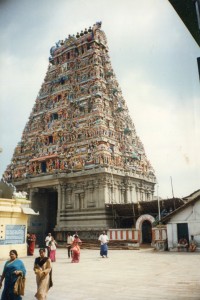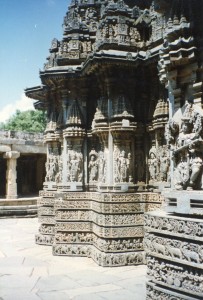Many Indian temples seem the opposite of Greek ones. Instead of reducing forms to clear lines, many Indian shrines project so many gods and forms in all directions that they can overwhelm you.
The variety of ideas about the meaning of temples is just as profuse.
Many have seen a temple as emanating from the spiritual energies that the universe differentiated from. The temple’s center is the naval of Brahman. All of nature emerged from this infinitely small point.
This point is also in the heart, and is called the hrdaya akasa. People can meditate on it and realize their unity with everything in the universe. The temple’s center represents this cosmic oneness that we all share.
The most influential ancient school of architecture is Vastu, which divides a building into squares. Each embodies a Hindu deity. Encompassing all squares is the Vastu Purusa. This is the cosmic self, and it animates the whole building. It lies across the entire floor, with the head in the northeast corner.
Many modern buildings are still designed according to Vastu. Two Indian women at a table next to mine in a Berkeley cafe were wondering about a strange architectural form projecting from the inside balcony of the upper floor. “I think it’s a Vastu thing.” The tradition that strangeness is a Berkeley thing didn’t enter her head.
Another idea of architecture correlates the height of a temple’s towers with different eras of cosmic time, called yugas. The apex of the highest tower represents the emanation of the universe, which flows downwards through the temple’s myriad forms.
Stella Kramrisch saw yet another spiritual meaning in sacred architecture. The different places and statues in a temple are states in the soul’s path to liberation.
Other ideas about temples’ meanings are more mundane. Kramrisch wrote that the stacks of roofs represent a hierarchy of souls. The vast caste system is thus projected into the heavens and called a sacred truth.
More vulgar meanings have also been seen. Richard Lannoy compared a temple’s form to a giant orgasm, as though the universe emerged from the procreative energy that generated all vegetation and animals.
So a temple’s meaning depends on where your head is. Like the caste system, a temple is a big enough field of meanings to accommodate anybody.
But all these meanings convey the sense of profuse flow. A temple isn’t the perfect static entity that the Greeks idealized. It embodies the emanation of the whole universe–all its life forms and levels of consciousness. It projects overwhelming abundance and expresses cosmic unity at the same time. These two ideas that we saw in the first two posts on India have been reinforced in its architecture as much as Greek temples express the West’s love of linearity.



Comments on this entry are closed.